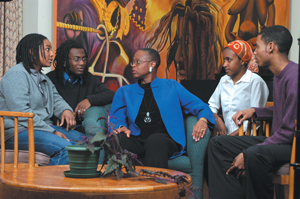


 |
 |
|
Around Tappan Square :: Page 4 :: Global Views
Jump to Page 1 : 2 : 3 : >4< : 5 : 6 : 7 : 8 : 9 : 10 of ATS
Global Views
African American studies is a model for interdisciplinary teaching.
by Yvonne Gay Fowler
 Clockwise from above: Lillie Johnson Edwards
’75 talks with students at Afrikan Heritage House. Mohammed
Ibn Chambas, executive secretary of the Economic Community of West
African States, discussed the issue of West African integration.
Clockwise from above: Lillie Johnson Edwards
’75 talks with students at Afrikan Heritage House. Mohammed
Ibn Chambas, executive secretary of the Economic Community of West
African States, discussed the issue of West African integration. |
Lillie Johnson Edwards ’75 often reminds her history students at Drew University to be deliberate in their decisions: “Your choices can impact the world,” she says. It’s a well-known mantra for Edwards and her African American classmates of the late 1960s and ’70s, for their choices helped give birth to the precursor of Oberlin’s Department of African American Studies.
“There was an excited sense of unity and diversity within the African American community on campus,” says Edwards. “Much of what we did was sit around tables and strategize. We strategically placed students on committees that were charged with making decisions.”
Leaders of the brand new program took a wide view of what could come under the aegis of African American studies, and the early curriculum included courses in anthropology, the dramatic arts, education, English, history, psychology, sociology, and the social sciences.
Now in its 30th year, the department is one of the most successful of its kind nationwide. A month-long anniversary celebration in April—with its focus on history, community development, art, and music—paid homage to the department’s growing ability to cover all areas of the black experience.
Throughout the month, keynote speeches were delivered by such distinguished guests as former Oberlin Professor Mohammed Ibn Chambas, now executive secretary of the Economic Community of West African States; author and feminist activist bell hooks, also a former Oberlin faculty member; and Omowale Satterwhite, the pro- gram’s first director.
Edwards, a noted historian and founding director of African American/African Studies at Drew University, was presented with the Alumni Association’s Distinguish-ed Achievement Award. She and others took part in alumni- and faculty-led discussions examining such topics as black art and activism, ending patriarchy, and the preservation of African American history. Maghan Keita ’72, a noted former student activist involved in molding Oberlin’s program, attributed its success to the “active participation and agency of very talented black people from its very inception.”
The first blacks at Oberlin, he said, included John Mercer Langston, one of the first African American lawyers in the U.S., and Mary Church Terrell, the first African American to be appointed to a board of education and a founding member of the National Association of Colored People (NAACP).
The intellectual caliber of those first blacks at Oberlin assured their
success, Keita added, and the success of the College and the success of
its black students “were bound in reciprocity.”
Highlighting the month’s festivities was a well-attended banquet
in Carnegie Building’s Root Room, where guests were treated to an
evening of jazz, opera, and a keynote address by Chambas on the challenges
of African development.
:::::
WebExtra:
Panelists Urge African American Studies Department
to Push Interdisciplinary Boundaries Ever Further
Looking Back to See Ahead: Panelists Discuss Keeping African American
History Alive
![]()